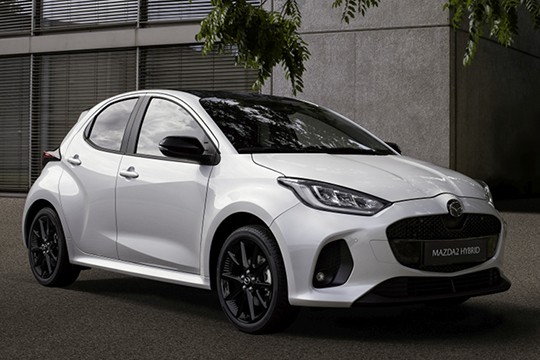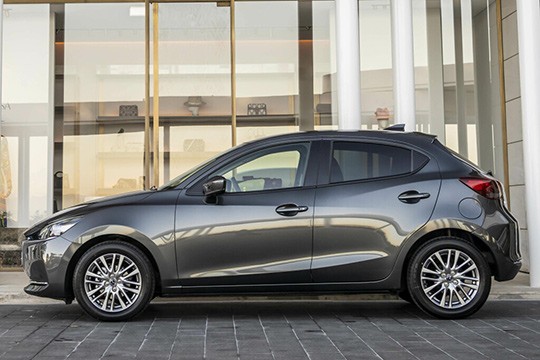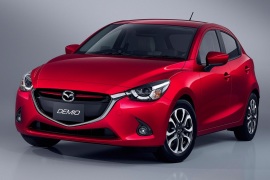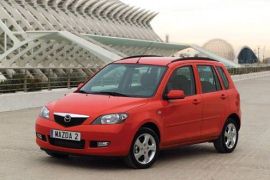MAZDA 2 / Demio Models/Series Timeline, Specifications & Photos
First production year: 2002
Engines: Hybrid gasoline, Mild hybrid, Gasoline, Diesel
Body style: Hatchback
Mazda unveiled the fourth generation of its small-sized vehicle, the 2, in 2023, and the brand’s aficionados were in shock since the car was, actually, a re-badged Toyota Yaris.
Toyota and Mazda joined forces, and it wasn’t for the first time. While the third generation of the Mazda2 was sold in several countries, including Canada, as a re-badged Toyota Yaris and Yaris sedan, on the fourth generation, they swapped places. As a result, the fourth generation of the Mazda2 became a hybrid and was a brand-engineered product for the Yaris. This happened since Mazda needed a hybrid vehicle, and it didn’t have enough time or money to develop one from the ground up. On the other hand, Toyota couldn’t say no to its partner. In 2015, the two Japanese automakers inked a deal, and eight years later, the final product entered the market after the third generation of the 2 was out and sent into retirement after a long and fruitful career that spawned across nine years.
Thanks to its size, the fourth Mazda2 fit into the B-segment vehicles class, which was very active and contested in Europe. To attract customers, the Mazda2 featured a sporty-looking front fascia with swept-back headlights and a grille that mostly resembled the one installed on its bigger siblings, the 6 and the CX5, which was flanked by a pair of scoops where the automaker installed the fog lamps. Furthermore, Mazda tried to make the car share at least some parts of this brand’s DNA instead of Toyota’s. As a result, customers could get it with a piano-black grille, door mirrors, roof, and B-pillars. Just like its twin sibling, the Yaris, the 2 was available as a five-door hatchback only. At the back, Mazda installed its badge on the tailgate and a trapezoidal-shaped lower apron integrated into the bumper.
The interior was also available with a wide choice of options. Customers could order the vehicle at a lower budget with a 9” display for the infotainment with an option for a 10.5” touchscreen placed atop the center stack. Fronting the driver was a digital instrument cluster with two dials for the speedometer and tachometer that flanked a TFT display that showed information from the car’s onboard computer. Moreover, Mazda provided the 2 with a 10-inch head-up display as an option. Despite the car’s urban destination, the automaker didn’t want its customers to feel like they were in a mundane vehicle and offered a set of bolstered front seats, which looked very sporty. In the back, the split-folding bench was wide enough for two adult-sized passengers, although legroom was not that big.
Mazda2 Hybrid was powered by Toyota’s 1.5-liter inline-three powerplant that ran in Atkinson cycle and a 59 kW electric motor. The total output of this system was 116 PS (114 HP), which were sent to the front wheels only via an e-CVT. Mazda2’s sporty look was confirmed by the stiff suspension and rigid bodywork, although it wasn’t a sports car; just a sporty five-door B-segment hatchback.
One of Japan's favorite superminis, the fourth generation of the Mazda Demio (also known as the Mazda2) was first released in 2014 and got a new makeover in 2019. It now looks fresher, however, not only the exterior design was updated, but some technical features as well. The hatchback's front and rear bumpers, front grille and headlights were updated to create a premium quality appearance.
New color schemes are available for the cabin and new leather filling to reinforce the visual and tactile quality.
The cabin's quietness was enhanced – the sound entering the cabin is now reduced and is definitely more pleasant for driver and passengers to communicate. The driving position was modified so that it maintains the spine's natural curve, which is the best sitting posture.
The hatchback is now equipped with an optional heated steering wheel. This option is excellent during winter and the function deactivates in 30 minutes from the moment it was turned on.
For a friendlier user experience, users can easily connect their mobile devices to the HMI (Mazda's Human-Machine Interface) to make calls, send messages, listen to music and get directions – either through Android Auto or Apple CarPlay.
Concerning the available powertrains, the customers have 3 gasoline (and gasoline only!) choices: Skyactiv G, 1.5L DOHC 16-valve gasoline engine – 75 PS and 90 PS with a 6-speed manual transmission and a 90PS with a 6-speed automatic gearbox. Safety features on this car include Advanced Smart City Brake Support, pedestrian detection, Lane Keep Assist, Traffic sign recognition and a 360 view monitor with parking sensors (this is available on high grade models). Definitely a nice refresh for Mazda and possibly a future supermini class leader.
The fourth generation of the Mazda 2 was unveiled at the Geneva Motor Show in 2014. It was the first Mazda 2 built from scratch after the separation with Ford Motor Company.
Mazda shared its components and platforms with Ford for a long period of time, when Ford owned a part of the Japanese car-maker. In November 2008, Ford sold 20% of its shares in Mazda, reducing its stakes at 13.4%. And the technology exchange slowed down. The last remaining Ford stakes in Mazda were sold in 2015. By that time, the Japanese car-maker was on its feet, fighting to revive its brand as an independent constructor and the Mazda 2 was one of the key vehicles.
With a design language similar to the compact-sized Mazda 3, the 2 featured the same “Kodo” language. It meant curved surfaces “in harmony with nature” as the officials said. A big, pentagonal, grille stood like a shield in front of the car. A big opening in the front bumper suggested the sporty character of the car. It wasn't completely untrue.
Inside, the car was well designed and proportioned. Depending on the trim level, a sat-nav system with a rotary knob controller between the seats was a carry-over from its bigger brother (or sister), the 3. According to its small-segment stature, the 2 was spacious enough for four (maybe five) adults and it still had some trunk to be used for weekly shopping.
For the engine compartment, the SkyActive engine family with 1.3- and 1.5-liter engines. Apart from the base engine, which was mated with a 5-speed manual, the others were mated to a 6-speed manual. An option for a 6-speed automatic was available.
Mazda unveiled the 2 at the 2007 Geneva Motor Show, and it was an instant success. Even though it was based on the same platform as the Ford Fiesta, its design attracted more eyes than its blue-oval badged sibling.
The Japanese carmaker made one of the best new-edge design vehicles in the small segment, blending curved lines and sharp angles, and named it Zoom-Zoom. Combined with a good reliability reputation for the carmaker, it resulted in high demand for the 2 from the European market.
Its sharp-looking headlights mounted high above the bumper were protected them from small parking bumps. The front flared fenders resembled the same idea met on its bigger brothers, the 3 and the 6. Thanks to the ascending beltline, the 2 offered a dynamic look, even though it was not a sports car or even a hot-hatch.
Inside, Mazda focused more on design and less on materials. Since it aimed at European customers, it arranged a black and silver combination for the dashboard and center stack. But make no mistake, all of these were made from plastic and not high-quality ones. Yet, it was appealing to customers. The three-dial instrument cluster featured a wider speedometer in the middle, flanked by a tachometer on the left and an LCD on the right. Even though it was not even a compact-sized vehicle, it still provided enough room for five adults inside, although the middle rear passenger had to cope with the center tunnel that crossed the car from front to back.
Its underpinnings were shared with the Ford Fiesta and featured a McPherson independent front suspension and torsion beam at the back. Thanks to its low overall weight, the 2 was a very nimble car with good fuel efficiency, especially if fitted with the 1.6-liter turbodiesel engine.
The Mazda 2/Demio was the second generation for the Demio name and it was based on the European Ford Fusion platform. It was the beginning of the cross-over era.
While its predecessor, which was launched in 1996, was based on the Mazda's DW platform, the 2002 version was on the DY platform, which was jointly developed with Ford. It was built to accommodate an all-wheel-drive system but to cost less than the previous one and perform better on the road. Depending on the market, the second generation of the Demio was also known as Mazda 2.
It was a cross-over between a small car and a light SUV. Its higher ground clearance and the hatchback body style was appealing, especially due to its new front fascia. The headlights style and the grille were inspired by its bigger brother, the Mazda 6. But since there were limitations regarding the body panels, the rest of the car featured a bland-looking beltline and a flat rear end.
Inside, the high roof design of the car allowed a generous headroom for the passengers. The steering-wheel had buttons for the stereo system and the overall design was clean. The high seating position and the high mounted rear bench allowed a comfortable ride for four adults. Since the car's width was not that generous, the shoulder room was hardly fit for three adults in the back.
For the engine compartment, the car was fitted with a choice of three gasoline and a diesel engine. In Japan, the car was available as a hybrid as well, with an electric motor for the rear axle and a gasoline unit in the front.




